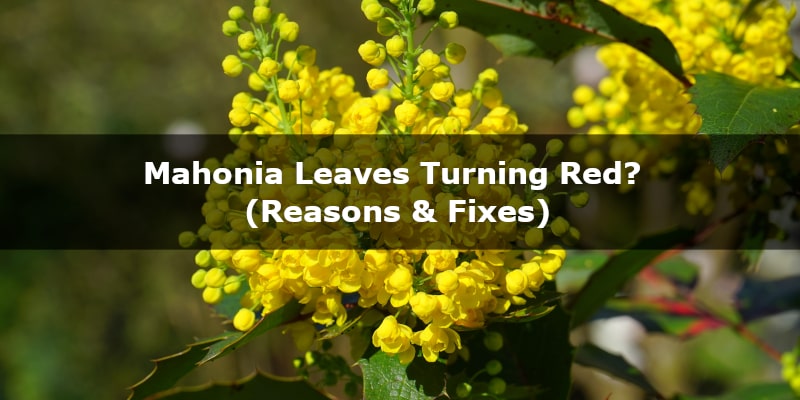If you are fond of growing the Mahonia plant, you must have encountered their leaves turning red. Sometimes it’s natural; other times, it might be cause for concern.
Here is what you need to know about it.
Why are Mahonia Leaves Turning Red?
The first and most common cause why your Mahonia leaves might be turning red is rust infection. Besides, it might be a reaction to unfavorable environmental conditions, powdery mildew, or just a natural feature of the variety you have planted.
Prevention is always a better option than looking for treatment. So, ensure you take good care of your Mahonia plant to avoid infection or disease.
Reason 1 – Rust Infection
When dealing with Mahonia leaves turning red, the foremost suspicion is always rust. It is one of the most common causes of red spots on Mahonia leaves and is caused by fungi.
The fungus responsible for rust grows during winter on leaf debris. As soon as early spring arrives and the weather is misty, these fungi release harmful substances on the plant’s leaves.
Resultantly, the affected area turns red. If you find red spots on the upper part of the leaves, it probably indicates that the rust infection has just started.
If left unattended, the infection will spread, and the red spots will turn into brown spots and spread to the bottom of the leaves. As the infection progresses, these brown spots form small holes in the leaves. Though the infection starts from younger leaves, it eventually affects the mature ones, halting the plant’s normal growth.
The fate of the affected leaves depends on the intensity of the infection. If the leaves are rusted to an extent of distortion, they will die and drop. However, if the infection has just started, it can be treated efficiently.
Once you have identified the rust infection, try removing all the affected leaves, even those with little red spots. Also, when watering the plant, ensure you are not watering overhead, as it will produce moisture and facilitate rust infection.
The infection also spreads if the plant is in a congested space. If you feel the plant isn’t getting enough space, try pruning to improve air circulation.
Though there are no specific conditions for pruning Mahonia, it is preferable to wait until early spring has passed and the flowering is completed.
Now that you have removed the affected leaves, pruned the plant for better air circulation, and watering the plant to prevent the spread of disease, spray a fungicide to combat the remnants of the infection. A good fungicide with copper, such as JDS Fungicide (buy it here), can help you get rid of the rust.
Remember that prevention is always better than treatment. If you maintain good air circulation and water the plant with the right technique, it’s highly unlikely that it will get a rust infection.
Reason 2 – Unfavorable Environmental Conditions
Mahonia plants grow well in an average environment. They need partial to full shade and well-drained acidic soil. Whether the atmosphere is too dry or too moist, both conditions are unfavorable for the growth of Mahonia.
Also, these conditions are not always related to the environment; sometimes, they might be triggered by the watering schedule. It will affect the leaves if you are not watering the plant or overwatering it.
If there is too much exposure to the sun or the wind is brutal, the leaves will develop yellow or reddish-brown spots. As the foliage is affected, it eventually dies and drops. This also results in a sunburn if left unattended.
For the treatment, you must identify the cause behind the distressed condition of the leaves. If it is due to moisture, you can effortlessly treat it by avoiding overhead watering. On the other hand, if it is because of dry conditions, you can use anti-transpirants to help the plant prevent moisture.
Reason 3 – Powdery Mildew
Another reason why Mahonia leaves turn red might be powdery mildew, an infection commonly found in the Mahonia plant. Though the spots are brown, they can take a reddish hue, and a gray powdery fungus also develops on the leaves.
This infection usually affects the lower side of the leaves and is a result of extended exposure to high moisture levels.
Your first line of defense against powdery mildew should be to avoid watering the leaves directly. Always water the soil and ensure your plant gets an adequate amount of sunlight.
If you take good care of your plant and this infection still develops, try a fungicide to treat it. However, you should remove the affected leaves before applying fungicide.
Reason 4 – A Natural Feature of the Variety
Sometimes, Mahonia leaves turning red might be a natural process. The leaves of some specific Mahonia varieties turn red in winter or at a certain time of the year. In this case, there’s no need to worry.
If your Mahonia leaves turn red, you should search for details about the variety you are growing. If it is a natural feature of your planted variety, it can save you a lot of hassle and tension.
References
growsonyou.com, horticulture.co.uk, pyracantha.co.uk, homeguides.sfgate.com, gardenguides.com, biology.stackexchange.com

